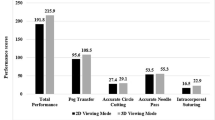Abstract
Purpose
Surgeons conventionally assume the optimal viewing position during 3D laparoscopic surgery and may not be aware of the potential hazards to team members positioned across different suboptimal viewing positions. The first aim of this study was to map the viewing positions within a standard operating theatre where individuals may experience visual ghosting (i.e. double vision images) from crosstalk. The second aim was to characterize the standard viewing positions adopted by instrument nurses and surgical assistants during laparoscopic pelvic surgery and report the associated levels of visual ghosting and discomfort.
Methods
In experiment 1, 15 participants viewed a laparoscopic 3D display from 176 different viewing positions around the screen. In experiment 2, 12 participants (randomly assigned to four clinically relevant viewing positions) viewed laparoscopic suturing in a simulation laboratory. In both experiments, we measured the intensity of visual ghosting. In experiment 2, participants also completed the Simulator Sickness Questionnaire.
Results
We mapped locations within the dimensions of a standard operating theatre at which visual ghosting may result during 3D laparoscopy. Head height relative to the bottom of the image and large horizontal eccentricities away from the surface normal were important contributors to high levels of visual ghosting. Conventional viewing positions adopted by instrument nurses yielded high levels of visual ghosting and severe discomfort.
Conclusions
The conventional viewing positions adopted by surgical team members during laparoscopic pelvic operations are suboptimal for viewing 3D laparoscopic displays, and even short periods of viewing can yield high levels of discomfort.




Similar content being viewed by others
References
Sakata S et al. (2016) The conflicting evidence of three-dimensional displays in laparoscopy: a review of systems old and new. Ann Surg 263(2):234–239
Woods, A.J. 2012 Crosstalk in stereoscopic displays: a review. J Electron Imaging 21(4)
Yang SN et al. (2012) Stereoscopic viewing and reported perceived immersion and symptoms. Optom Vis Sci 89(7):1068–1080
Howarth PA (2011) Potential hazards of viewing 3-D stereoscopic television, cinema and computer games: a review. Ophthalmic Physiol Opt 31(2):111–122
Grove PM (2012) In: Zhu C, Zhao Y, Yu L, Tanimoto M (eds) The psychophysics of binocular vision, in 3D-TV system with depth-image-based rendering. Springer, New York, pp. 347–373
Lee CT, Lin HY, Tsai CH (2010) Designs of broadband and wide-view patterned polarizers for stereoscopic 3D displays. Opt Express 18(26):27079–27094
Poudel, S., et al. 2016 Impact of 3D in the training of basic laparoscopic skills and its transferability to 2D environment: a prospective randomized controlled trial. Surg Endosc
Sakata S et al. (2016) The impact of three-dimensional imaging on polyp detection during colonoscopy: a proof of concept study. Gut 65(5):730–731
Jin, E.W., et al. 2005 Creating a comfortable stereoscopic viewing experience: effects of viewing distance and field of view on fusional range
Kooi FL, Toet A (2004) Visual comfort of binocular and 3D displays. Displays 25(2–3):99–108
Sakata, S., P.M. Grove, and A.L. Stevenson 2016 Effect of 3-dimensional vision on surgeons using the da vinci robot for laparoscopy: more than meets the eye. JAMA Surgery
Zaroff CM, Knutelska M, Frumkes TE (2003) Variation in stereoacuity: normative description, fixation disparity, and the roles of aging and gender. Invest Ophthalmol Vis Sci 44(2):891–900
Stevens, S.S. 1975 Psychophysics. Transaction Publishers
Kennedy RS et al. (1992) Use of a motion sickness history questionnaire for prediction of simulator sickness. Aviat Space Environ Med 63(7):588–593
Peters JH et al. (2004) Development and validation of a comprehensive program of education and assessment of the basic fundamentals of laparoscopic surgery. Surgery 135(1):21–27
Kennedy RS, Berbaum KS, Lilienthal MG (1997) Disorientation and postural ataxia following flight simulation. Aviat Space Environ Med 68(1):13–17
Solimini AG (2013) Are there side effects to watching 3D movies? A prospective crossover observational study on visually induced motion sickness. PLoS One 8(2):e56160
Acknowledgments
Laparoscopic displays were provided to us by Olympus Japan for the purpose of independent research. Dr. Sakata received financial assistance from the Avant Doctors in Training PhD Scholarship. The funding source had no role in study design, data collection, analysis or interpretation, report writing or the decision to submit this paper for publication.
Author information
Authors and Affiliations
Corresponding author
Ethics declarations
Conflict of interest
All authors declare no conflict of interest, financial or otherwise.
Ethics approval
The study was approved by the University of Queensland (UQ) Human Research Ethics Committee.
Contributions
Dr. Sakata led the conceptualization, planning, execution of this research, analysis and writing the manuscript; Drs. Grove, Hill, Watson and Stevenson contributed to the planning, analysis and manuscript writing.
Rights and permissions
About this article
Cite this article
Sakata, S., Grove, P.M., Hill, A. et al. The viewpoint-specific failure of modern 3D displays in laparoscopic surgery. Langenbecks Arch Surg 401, 1007–1018 (2016). https://doi.org/10.1007/s00423-016-1495-z
Received:
Accepted:
Published:
Issue Date:
DOI: https://doi.org/10.1007/s00423-016-1495-z




